 INDEX
INDEX INDEX
INDEX
Prepared by the Secretary Of Energy Advisory Board
Task Force on Alternative Futures for the Department of Energy National Laboratories
February 1995
Figure 1. Department of Energy National Laboratories Under Consideration by the Task Force
Robert Galvin (Chairman) Chairman of the Executive Committee
Motorola Inc.
Braden Allenby
Research Vice President, Technology and Environment
AT&T
Bob Boylan
Successful Presentations
A Division of Boylan Enterprises, Inc.
Linda Capuano
Vice President,
Operations and Business Development
Conductus, Inc.
Ruth Davis
President and Chief Executive Officer
Pymatuning Group
Marye Anne Fox
Vice President for Research
Waggoner Regents Chair
Department of Chemistry
University of Texas
Benjamin Huberman
President
Huberman Consulting Group
Shirley Jackson
Professor,
Department of Physics and Astronomy
Rutgers University
Lynn Jelinski
Director, Center for Advanced Technology (Biotechnology)
Cornell University
Henry Kendall
Professor of Physics, Massachusetts Institute of Technology
Chairman, Union of Concerned Scientists
Daniel Kerlinsky
President, New Mexico Physicians for Social Responsibility
Children's Psychiatrist
University of New Mexico
Richard Lester
Director, MIT Industrial Performance Center
Professor of Nuclear Engineering
Massachusetts Institute of Technology
Roger Little
President and Chief Executive Officer
Spire Corporation
Edith Martin
Executive Vice President and Chief Technology Officer
Sallie Mae
James P. McCarthy
General, USAF (Ret)
Olin Professor of National Security
US Air Force Academy
Mark Murphy
President
Strata Production Company
Richard Nelson
George Blumenthal Professor of International and Public Affairs, Business, and
Law
Columbia University
Edward Roberts
David Sarnoff Professor of Management
Faculty Chair, Management of Technology Program
Massachusetts Institute of Technology
Benjamin M. Rosen
Chairman of the Board, Compaq Computer
Partner
Sevin Rosen Management
Harvey M. Sapolsky
Director, MIT Defense & Arms Control Studies Program
Professor of Public Policy
Massachusetts Institute of Technology
William Spencer
President and Chief Executive Officer
SEMATECH
Victoria Tschinkel
Senior Consultant
Landers & Parsons
Herbert York
Director Emeritus of the Institute for Global Conflict and Cooperation
University of California
Task Force Staff
Peter F. Didisheim
Executive Director
Secretary of Energy Advisory Board
U.S. Department of Energy
Michele M. Donovan
Task Force Director
U.S. Department of Energy